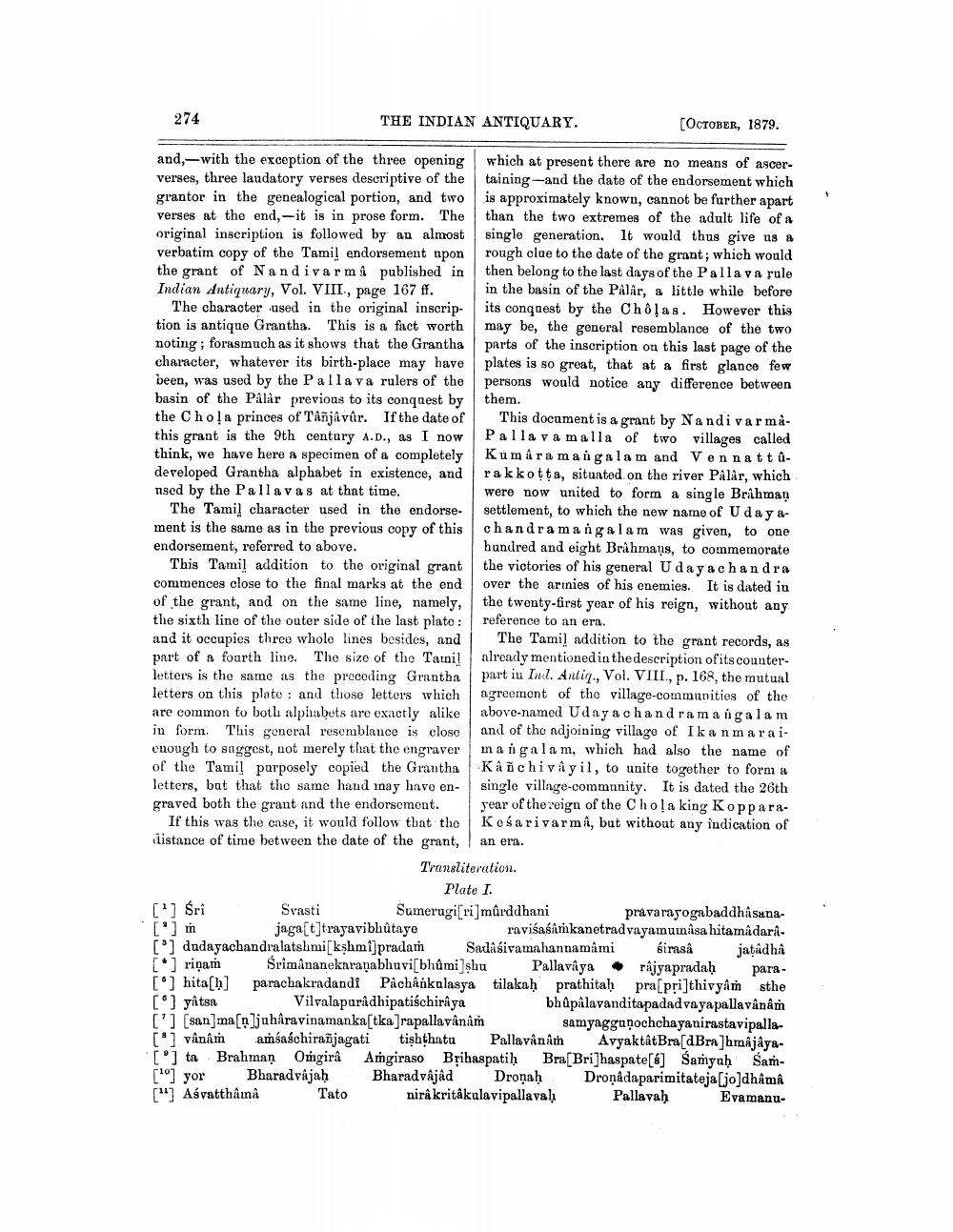________________
274
THE INDIAN ANTIQUARY.
and, with the exception of the three opening verses, three laudatory verses descriptive of the grantor in the genealogical portion, and two verses at the end,-it is in prose form. The original inscription is followed by an almost verbatim copy of the Tamil endorsement upon the grant of Nandivarmâ published in Indian Antiquary, Vol. VIII, page 167 ff.
The character used in the original inscription is antique Grantha. This is a fact worth noting; forasmuch as it shows that the Grantha character, whatever its birth-place may have been, was used by the Pallava rulers of the basin of the Pâlàr previous to its conquest by the Chola princes of Tâñjâvûr. If the date of this grant is the 9th century A.D., as I now think, we have here a specimen of a completely developed Grantha alphabet in existence, and nsed by the Pallavas at that time.
The Tamil character used in the endorsement is the same as in the previous copy of this endorsement, referred to above.
[OCTOBER, 1879.
which at present there are no means of ascertaining-and the date of the endorsement which is approximately known, cannot be further apart than the two extremes of the adult life of a single generation. It would thus give us a rough clue to the date of the grant; which would then belong to the last days of the Pallava rule in the basin of the Pâlâr, a little while before its conquest by the Chôļas. However this may be, the general resemblance of the two parts of the inscription on this last page of the plates is so great, that at a first glance few persons would notice any difference between them.
[1] Śri
[] m
This document is a grant by Nandi varmaPallava malla of two villages called Kumaramangalam and Vennattûrakkotta, situated on the river Pålår, which were now united to form a single Brahman settlement, to which the new name of Udayachandramangalam was given, to one hundred and eight Brahmaus, to commemorate the victories of his general Udayachandra over the armies of his enemies. It is dated in the twenty-first year of his reign, without any reference to an era.
The Tamil addition to the grant records, as already mentioned in the description of its counterpart in Inl. Antiq., Vol. VIII., p. 168, the mutual agreement of the village-communities of the above-named Udayachandramangalam and of the adjoining village of Ikanmaraimangalam, which had also the name of Kanchivayil, to unite together to form a single village-community. It is dated the 26th year of the reign of the Chola king KopparaKesarivarma, but without any indication of
This Tamil addition to the original grant commences close to the final marks at the end of the grant, and on the same line, namely, the sixth line of the outer side of the last plate: and it occupies three whole lines besides, and part of a fourth line. The size of the Tami! letters is the same as the preceding Grantha letters on this plate: and those letters which are common to both alphabets are exactly alike in form. This general resemblance is close enough to suggest, not merely that the engraver of the Tamil purposely copied the Grantha letters, but that the same hand may have engraved both the grant and the endorsement.
If this was the case, it would follow that the distance of time between the date of the grant, Transliteration. Plate I.
Sumerugi[ri] mûrddhani
an era.
Svasti
pravarayogabaddhâsanaraviśaśâmkanetradvayamumasa hitamâdarâ
jagat]trayavibhutage
sirasâ
jatâdhâ
[] dudayachandralatshmi[kshmi]pradam Sadasivamahannamâmi [] ripam
Śrîmânanekaraṇabhuvi[bhumi]şhu Pallavaya rajyapradaḥ para[] hita[b] parachakradandi Pâchânkulasya tilakaḥ prathitaḥ pra[pri]thivyâm sthe [*] yâtsa bhipilavanditapadad vayapallavini
Vilvalapuridhipathinlys
samyagganochehayanirastavipalla
['] [san]ma[]juhkravinamanka[tka]rapallavināṁ [*] vânấm amishirajagati tishthatu Pallavânâm AvyaktieBradBm]hmājāya[] ta Brahman Odgir Amgiraso Brihaspatih Bra Brihaspate([6] Samyub Sa
[10] yor Bharadvajaḥ Bharadvajad Dronaḥ Dropidaparimitateja[jo]dhâm
["] Asvatthâmâ
Tato
nirâ kritâkulavipallaval
Pallavah
Evamanu




